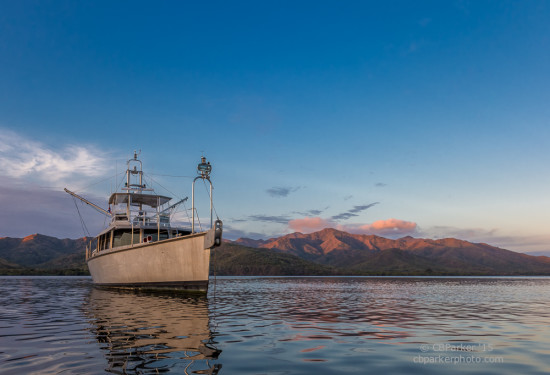Thursday’s sail took us just over the border from Nicaragua into Costa Rica. It was a windy day, gusting nearly to 40, and the waves, though small, were whipped into whitecaps. Rod kept as close to shore as he could, taking advantage of the wind shadow, and by end of the day our recorded track on the chart looked more like a beach walk than a sail! Even so, AVATAR was well coated in salt spray when we reached our overnight destination. It did afford us a close up view of some pretty impressive mansions spaced along the Nicaraguan coast, most memorably this solar powered creation striking for its blue domes.
Bahía Santa Elena is located within one of Costa Rica’s many national parks, as about 25% of the country is preserved in parkland. The next day when we we cleared in at Marina Papagayo in Bahía Culebra, we were within easy driving distance of multiple national parks. Our route from Santa Elena to Culebra took us across the Gulf of Papagayo, reputedly the next windiest stretch of water along this coast since Tehuantepec. But for us the water was flat calm and the only obstacles along the way besides some starkly bleak islands and rock outcroppings were the dozens of sea turtles floating on the surface. Their shell backs make an olive brown mound in the water, often adorned by a seabird perched on top, until they register our approach at which time they raise their heads out of the water for a quick look before disappearing in a flurry of a splash to get out of the way.
Using the links below you can see and interact with our track on the internet from Bahía Santa Elena to Bahía Culebra, or download a file that will let you ‘fly’ the track using Google Earth.
Track recorded with Navionics App.
View it: http://tinyurl.com/n7atwhx
Download it: http://tinyurl.com/kt5ervo
For shore leave we rented a car and drove inland to visit the park Rincon de la Vieja which encompasses a volcano of that name. We stretched our legs hiking park trails that led to waterfalls, hot springs, steaming fumaroles and bubbling mud pots, interspersed with tropical forest populated by a variety of animals not seen in the wild in North America – monkeys, tapirs, anteaters, exotic birds, butterflies the size of dinner plates.
We did recognize a squirrel, but it had a ringed tail and blotchy cream and sable coloring. Rod and May spotted a huge blue butterfly which I missed because I was picking my way across stepping stones in a muddy stream. But I was able to photograph a small animal the size of a football that, after researching it on the web, turns out to be a Central American agouti, common to Panama. We also spied a large crested bird the size of a goose, as yet unidentified since I don’t have a bird ID book for this part of the world. I managed to capture a partial photograph of it hiding in the brush – not exactly in the ‘keeper’ category but most likely the only photo I’ll ever capture of this particular species;-)
The marina where we stayed was part of a high end development offering every amenity for visitors and residents. The entire peninsula has been platted for a resort destination, accomodating upscale residences, apartments, and hotel properties anchored by not only the marina but a gorgeous golf course, beautiful landscaping, ocean vistas, and the Four Seasons Beach Club and restaurant.
To match all this luxury, prices for everything from a beer to real estate were stiff – as much or more than I would expect to pay for the same thing in the states – dramatically more than anywhere else on this entire trip from Mexico onwards. Real estate signs alongside the country roads showed price tags of US$24 per square meter.
Next post – Panama. Almost there!
Click on any photo below to open a slideshow of the above photos and additional images.
